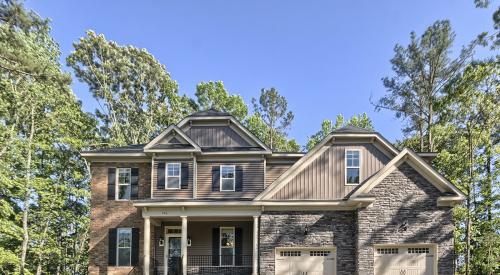|
When Steve Wall, 48, left his leadership position at Texas Giant Choice Homes in January of 2005, after six years as its CEO, industry insiders predicted it wouldn't take long for him to land on his feet. By April, Wall had his own home building company, operating in Dallas, Fort Worth, Houston, San Antonio and Austin with $50 million from investment banking behemoth Warburg Pincus behind him to help pay the bills.
|
|
The surprise is that Arlington, Texas-based Wall Homes is not building in the entry-level sector, where Wall led Choice to No. 48 with 3,822 closings, for $496.5 million in 2004 revenue in Professional Builder's 2005 Giant 400 rankings. Rather, Steve Wall is taking on David Weekley Homes, The Drees Co., Wilshire Homes and a host of others in Texas' ultra-competitive move-up market. He's intent on carving a niche as a design leader.
"I hired an architect the first week we were open," Wall says. "I knew that would be critical to our success. We've had a 15-year run of building entry-level houses in Texas, but I could see a decline coming in that segment more than a year ago. Costs are going up and so are interest rates. Lots are more expensive, and there are fewer people in the market for a first home. But all those entry buyers we sold houses to for the last 15 years are now itching to move up.
"We started our company with the intent to do first and second move-up product, which is where I believe the action will be in Texas for the rest of this decade. Our target price range is from $150,000 to $300,000—Those families stuck in entry-level houses are looking for a reason to move up. They don't just want a bigger version of the house they've got now. They need dream fulfillment to coax them into that next step."
Architectural Answer"For too many years, houses in this market have been built with cost as 90 percent of the consideration. That needs to change," Wall says. "Design can be the reason for moving up. We want to offer a product that looks better and lives better, as well as being larger. I have a look that I want, with stone and brick on the elevations and rooflines and porches that look like those on houses that are much more expensive."
Wall's father was a masonry contractor, so it's no surprise he values it: "You'll see us mix stone and brick and eventually stucco," he says. "But they have to look like they belong together. Classic Texas elevations do that," Wall says.
With the goal to establish a design leadership position in the first and second move-up markets, Wall embraced a strategy that is the opposite of the famous 'Rayco' marketing and production model, which calls for stripping base prices to bare square footage. "Ten years ago, price per square foot was all people cared about," Wall says. "Today, you have to build quality into the space to induce that emotional connection with the product. We're putting barrel ceilings and spiral staircases into houses. We're looking for features that people associate with much more expensive homes. We want to bring those features pioneered in the custom market into the first and second move-up market.
"It really starts with the exteriors. People want homes that are interesting — something they can be proud of. Not unique and unusual, but classic and expensive-looking. There are not a lot of people out there just buying space anymore."
Pollard's BrainstormWall credits purchasing manager Kelly Pollard with a brainstorm idea he believes will give Wall Homes a critical edge on features included in base prices. "Most builders who operate at this price point try to squeeze manufacturers and suppliers down to the lowest price they can get on the standard specs in a house," Wall says. "Those people don't make a lot of money on the base, but they make up for it by increasing their margins on options and upgrades. But we're taking a different tack.
"Most of our buyers want upgraded carpet, tile, cabinets, countertops and fixtures," Wall says. "So Kelly came up with the idea to negotiate our prices on the upgrades, not on a builder-basic spec for each house. We told the manufacturers we don't even want any base-spec products. Just give us a price on the upgrades that allows us a competitive advantage at the spec level we know our buyers want anyway."
After building a platform in the $150,000 to $300,000 price range, Wall anticipates moving up again, into the $350,000 to $600,000 range. "Eventually, we want to build houses that compete with custom builders in design and features but employ what we've learned in the entry market about process control and efficiency to be more price competitive than the custom guys can ever be," Wall says.
When asked why he chose to enter all four of the big Texas markets at once rather than establish a strong market share in one before entering the others, Wall says he did so because he could. "We have people who know the developers and land owners. We've got long-standing relationships on the land side in all those markets," Wall explains. "We're not going into any uncharted waters."
The key to that is the large number of executives that Wall brought with him from Choice, including Matt Bilardi. This land acquisition exec is now vice president of real estate at Wall Homes. Andrew Brimberry, Wall's director of information technology, is building the systems at Wall Homes from a J.D. Edwards platform. "Andrew and I have worked together for a long time," Wall says. "We'll create a lot of custom-programmed tools that will sit beside the base system and provide us with the flexibility we need to expand."
How big will Wall Homes be by the end of this decade?
"I'd say we should be doing 4,000 homes a year," Wall predicts, "after adding two more markets out of state."
Wall sees Atlanta as a natural for his new firm because he had a division there for Choice. He's also looking at Florida and Phoenix. "It all depends on timing," Wall says. "You never can time it perfectly, but we want to go into new markets when we have a great chance to succeed."
Cultural ConnectionWall's skyrocket start must be the product of his leadership. How does he get people like Matt Bilardi, Andrew Brimberry, Kelly Pollard and chief-of-staff Erin Kolp to follow him?
Kolp, for one, had no worries about leaving Choice to work with Wall. "I didn't expect a downside," she says. "It had a lot to do with him and his character."
Wall was also smart enough to hold a chunk of equity earmarked for the people he needed to recruit to put the new company on a fast track to success. "Warburg Pincus is a great partner," Wall says. "They're very smart business people. They own a significant share of the company, but we also kept a significant share to use to recruit key people."
Even so, the people who follow Steve Wall have to be convinced he will succeed or even the equity wouldn't be enough. "I believe in establishing a winning culture," Wall says. "There's a guy on the West Coast who has been a mentor for me — Peter Koestenbaum. He was on the cover of Fast Company magazine in the late 1990s. I called him and went to one of his workshops. I engaged him personally. He coached me through my first try at being a CEO in 1999. He told me that building a leadership culture is the whole key to growing a company. You have to have it to get people to take ownership and personal responsibility for what happens.
"I want the people who help me do this (Wall Homes) to benefit from it. It was a leap of faith for Warburg to go this way because I did give away so much stock. Basically, they gave me the deal I asked for — stock for all the charter members of our team."
Peter Koestenbaum, founder and chairman of the Koestenbaum Institute in Carmel By The Sea, Calif., holds degrees from Stanford University, Harvard University and Boston University in physics, music and philosophy. He founded an accredited institute for teachers, nurses, physicians and psychiatrists. Later in life, he came to the world of business and built a client list that includes IBM, Ford, Citibank, Volvo and Amoco. He has written four books on management.
"People are loyal to him — not because they make money. They respect him," Koestenbaum says. "I've been a consultant for easily 60 years, and I haven't met many people of his caliber."
Riding art niches, 10-foot ceilings, arched entryways, stone fireplaces and carriage house garage doors, Wall Homes will be a company to watch over the next few years. This is no Rayco.
|













